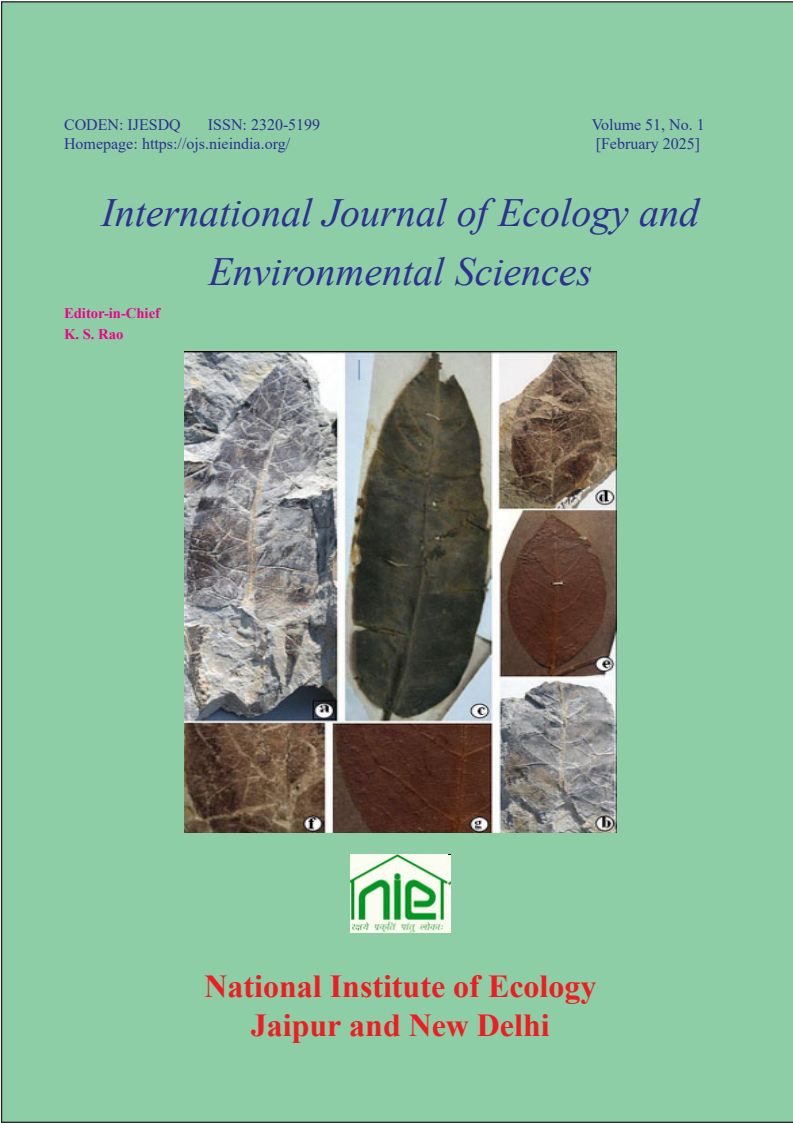Heavy Metal Detection and Antibacterial Activity of Phytosynthesized Copper oxide (CuO) Nanoparticles using Leaf Extract of Colocasia esculenta
DOI:
https://doi.org/10.55863/ijees.2025.0524Keywords:
CuO-NPs, Colocasia esculenta, phytosynthesis, heavy metal, detection, antibacterialAbstract
Phytosynthesis of metal nanoparticles offers a facile and stable approach for their production and applications. In this study, CuO nanoparticles (CuO-NPs) were effectively synthesized using Colocasia esculenta plant leaf extract as a capping and bio-reducing agent. The spectroscopic analysis, XRD, confirmed the crystalline hexagonal primitive structure of the CuO-NPs with a crystal size of 42.14 nm, whereas the UV- VIS spectroscopy reflected the absorption peak at 260 nm. The CuO-NPs displayed significant potential for detecting and removing Pb2+ heavy metal from water with a detection limit of 29 µM. CuO-NPs exhibited excellent sensitivity and selectivity for Pb2+ in the presence of several interfering metals. The adsorption isotherm displayed the Langmuir working model for Pb2+ adsorption. Prominent antibacterial activity was also indicated by the phytosynthesized CuO-NPs against Gram-positive and Gram-negative bacteria, suggesting their prospective role for antimicrobial applications. Thus, the study highlights an easy, cost-effective, non-toxic way of synthesis of CuO-NPs utilizing the leaf waste of Colocasia esculenta, offering an insight into their probable applications for heavy metal detection and antimicrobial activity.
References
Akintelu, S.A., Folorunso, A.S., Folorunso, F.A. and Oyebamiji, A.K. 2020. Green synthesis of copper oxide nanoparticles for biomedical application and environmental remediation. Heliyon, 6(7), e04508. https://doi.org/10.1016/j.heliyon.2020.e04508
Barman, K., Dutta, P., Chowdhury, D. and Baruah, P.K. 2021. Green biosynthesis of copper oxide nanoparticles using waste colocasia esculenta leaves extract and their application as recyclable catalyst towards the synthesis of 1, 2, 3-triazoles. Bio Nano Science, 11, 189-199. https://doi.org/10.1007/s12668-021-00826-5
Behzadi, S., Serpooshan, V., Tao, W., Hamaly, M.A., Alkawareek, M.Y., Dreaden, E.C. and Mahmoudi, M. 2017. Cellular uptake of nanoparticles: journey inside the cell. Chemical society reviews, 46(14), 4218-4244. https://doi.org/10.1039/c6cs00636a
Gupta, V and Chandra, N. 2020. Biosynthesis and antibacterial activity of metal oxide nanoparticles using Brassica oleracea subsp. botrytis (L.) leaves, an agricultural waste. Proceedings of the National Academy of Sciences, India Section B: Biological Sciences, 90, 1093-1100. https://doi.org/10.1007/s40011-020-01184-0
Kolahalam, L.A., Prasad, K.R.S., Krishna, P.M., Supraja, N. and Shanmugan, S. 2022. The exploration of bio-inspired copper oxide nanoparticles: synthesis, characterization and in-vitro biological investigations. Heliyon, 8(6), e09726. https://doi.org/10.1016/j.heliyon.2022.e09726
Maji, P and Pal, D. 2024a. Surface functionalization process: Its advantages and disadvantages. Pp. 141-157. In: Mukhopadhyay, M. and Bhattacharya, D. (Eds.). Nanocellulose: A Biopolymer for Biomedical Applications, Wiley-Scrivener Publishing, New York. https://doi.org/10.1002/9781394172825.ch6
Maji, P. and Pal, D. 2024b. Phytosynthesized copper oxide nanoparticles and their application in Pb2+ detection from surface water. Applied Physics A, 130, art 167. https://doi.org/10.1007/s00339-024-07770-7
Maji, P., Pal, D. and Dutta, S. 2023. Highly sensitive and selective Colorimetric detection of Pb2+ ions in water by biosynthesized CuO-NPs and its Antimicrobial potential”, Ideal International E- Publication, 1, 119-123, (ISBN: 978-93-89817-84-3)
Mandal, S., Calderon, J., Marpu, S.B., Omary, M. A. and Shi, S.Q. 2021. Mesoporous activated carbon as a green adsorbent for the removal of heavy metals and Congo red: Characterization, adsorption kinetics, and isotherm studies. Journal of Contaminant Hydrology, 243, 103869. https://doi.org/10.1016/j.jconhyd.2021.103869
Murthy, H.C., Desalegn, T., Kassa, M., Abebe, B. and Assefa, T. 2020. Synthesis of green copper nanoparticles using medicinal plant Hagenia abyssinica (Brace) JF. Gmel. leaf extract: Antimicrobial properties. Journal of Nanomaterials, 2020, Art. 3924081 https://doi.org/10.1155/2020/3924081
Tan, Z., Peng, T., Tan, X., Wang, W., Wang, X., Yang, Z. and Wu, M. 2020. Controllable synthesis of leaf like CuO nanosheets for selective CO2 electroreduction to ethylene. ChemElectroChem, 7(9), 2020-2025. https://doi.org/10.1002/celc.202000235
Downloads
Published
How to Cite
Issue
Section
License
Copyright (c) 2024 Dibyarupa Pal, Pratyasa Bandyopadhyay, Souparna Bhowmick, Pranabi Maji

This work is licensed under a Creative Commons Attribution-NonCommercial 4.0 International License.


